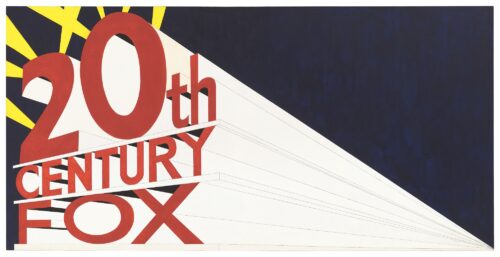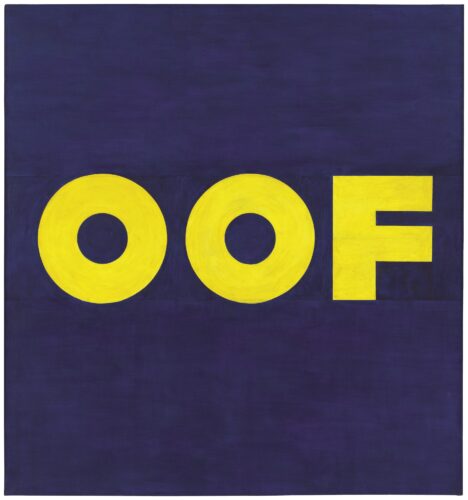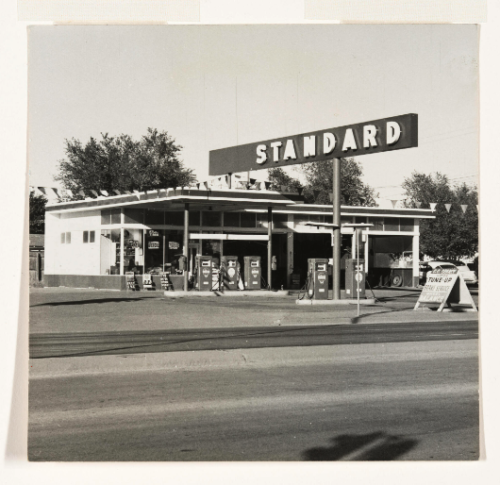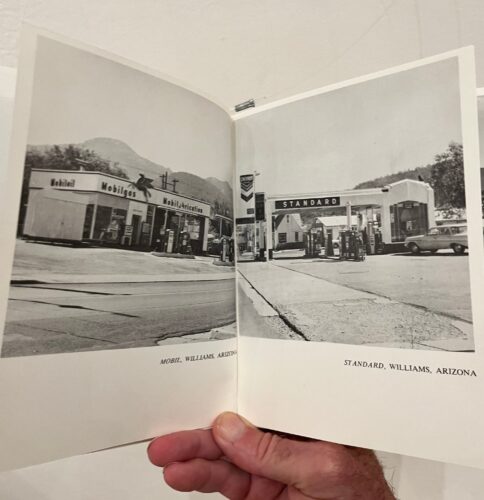By the time 18-year-old Ed Ruscha lit out on Route 66 in 1956, enroute from his home in Oklahoma City to study art in Los Angeles, the venerable U.S. highway had already been carrying motorists from Chicago to the coast and back for 30 years. Bobby Troup’s famous song, (Get Your Kicks on) Route 66, had been romanticizing the highway for a decade.
The young Ruscha was captivated by Route 66, at the time America’s principal east-west artery, so much so that he felt compelled to document it in photographs during his repeated trips back and forth between his childhood home and his new one. The boxy, prefab gas stations that provided automotive sustenance along the journey frequently found their way into Ruscha’s viewfinder.
Ed Ruscha / Now Then, a monumental, career-spanning retrospective at the Museum of Modern Art, pays due appreciation to Ruscha’s early fascination with Route 66’s fuel franchises before accelerating to trace the 85-year-old pop art pioneer’s six-decade career. Included are his groundbreaking masterpieces of the 1960s, his expressive interpretation of powerful words like Boss and Oof, his redundant photographing of LA streets, and his experimentation with unusual media like oil, gunpowder, and his own blood. The exhibition includes over 200 works, produced from 1958 to the present, in various media—including painting, drawing, printmaking, photography, artist’s books, and installation—and takes up the Manhattan museum’s sixth floor.
While Ruscha’s career has had many twists and turns – like, say, a highway – there is little debate about the significance of the inspiration he gained as a young man plying the pavement along Route 66. “I don’t have any Seine River like Monet,” he once said. “I’ve just got US 66 between Oklahoma and Los Angeles.” What began as a collection of desultory snapshots of the utilitarian fuel stops led to some of pop art’s most enduring works that captured an America in transition, a booming nation on the move.
His 1963 masterpiece Standard Station, Amarillo, Texas captured America’s past in its depiction of a descendent of Standard Oil, the company founded in the heady days of Gilded Age America by John D. Rockefeller, whose rise to wealth and power mimicked that of the United States after World War II. At the same time, the subject’s prefab architecture, mechanized pumps, and ostentatious mid-century signage captured early 60s modernism. And, all the while, its straight lines, forward slant, angularity, and careening searchlights suggest the way toward America’s future.
Ruscha made many versions of Standard Station, including the day and night oil on canvas renderings that are part of the MOMA retrospective. Others include Burning Gas Station, 1965–66, which depicts the Standard Station on fire; Mocha Standard, 1969, which replaces the bright colors of the original with coffee brown hues; Cheese Mold Standard with Olive, 1969, which does the same, but with greenish tints; Double Standard, 1969, which crosses the Standard sign with an even larger version of itself; and Ghost Station, 2011, in which color is eliminated completely. Standard Collage, a smaller monochromatic collage piece from 1989 depicting the same subject, is also part of the MOMA exhibition.
It turns out the seeds for Ruscha’s love affair with the service station had roots in his hometown of Oklahoma City at a time when his future had yet to be claimed by his artistic ambitions. He talked about it during a 2018 interview with Kasper Bech Dyg at the Louisiana Museum of Modern Art (LMMA) in Humlebæk, Denmark.
“When I lived in Oklahoma, I had a friend who lived in a very small concrete block house that resembled a gas station. And I started looking at gas stations as though it was architecture and very simple architecture at that. And some gas stations…were prefabricated and made of metal panels that were just literally put together and bolted together. And so, I began to see it as a beautiful form of architecture and I could even see myself living in something like this and making this my home,” he said.
The MOMA exhibit worthily catalogs the ascent of Ruscha’s early highway inspirations. Not only are two of the famous depictions of Standard Station represented, so are the precursor photographs made years earlier. His groundbreaking, 1963 self-published book of photographs, Twentysix Gasoline Stations, is featured, including a copy hanging from a string on a wall that visitors are encouraged to thumb through.
Twentysix Gasoline Stations, which has been cited as a significant contributor to the evolution of art publishing, was initially rejected by the Library of Congress when Ruscha sought copyright because of its unorthodox approach and lack of written content. It didn’t seem to bother the artist much: In 1964, he advertised his creation as “REJECTED” in ArtForum. Among the photographs featured at MOMA are three 1962 images of Standard Stations: Standard Station, Amarillo, Texas, (from which the painting was derived); Standard, Figueroa Street, Los Angeles; and Standard, Rimmy Jim’s, Arizona.
“Most of these gas stations I only took one picture and I saw a value in the snapshot of the very simple rudimentary idea of just holding a camera up, snapping it and moving on,” Ruscha said in the LMMA interview.
“I had these photographs that I had taken of gas stations across the western U.S. Then I began to see them as a sort of travel log, and I knew I wanted to produce a book of some kind and it’s almost like I needed an excuse to make a book and these photographs were my excuse. And I thought that was something to go on,” he said.
As important as Ruscha’s romance with filling stations was to his development and success as an artist, the MOMA retrospective is hardly a celebration of the Standard Station works alone. Now Then is the most comprehensive retrospective of the artist’s work ever staged, and his first solo exhibition at MOMA.
It includes many of his most familiar works, including Large Trademark with Eight Spotlights, the 1962 piece that depicts the 20th Century Fox logo and foreshadowed Standard Station with its steep angles, spotlights, and stark three-color presentation. Also on hand are Boss, Honk and, OOF three of his monosyllabic word paintings created between 1961 and 1962 that demonstrate the artists fascination with the shape, sound, and impact of language.
Ruscha’s 1970 multisensory Chocolate Room—the artist’s only single-room installation—has been refabricated for the retrospective. Originally created for the US pavilion during the 35th Venice Biennale in 1970, the room was created by screen printing chocolate paste onto hundreds of sheets of paper, lining the walls from floor to ceiling.
The exhibition, which runs through January 13 before moving on to the Los Angeles County Museum of Art, was created in close collaboration with Ruscha uniting many of the works for the first time. “‘It will be like various acquaintances gathering for a reunion,” he predicted in advance of the show’s opening.





